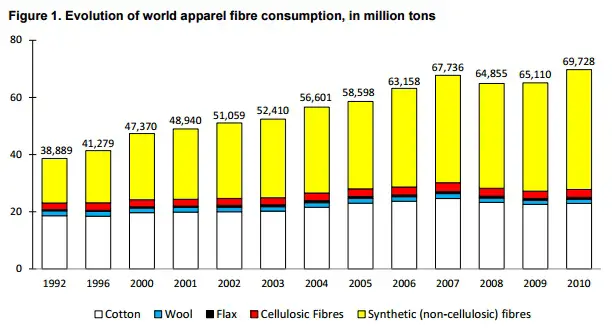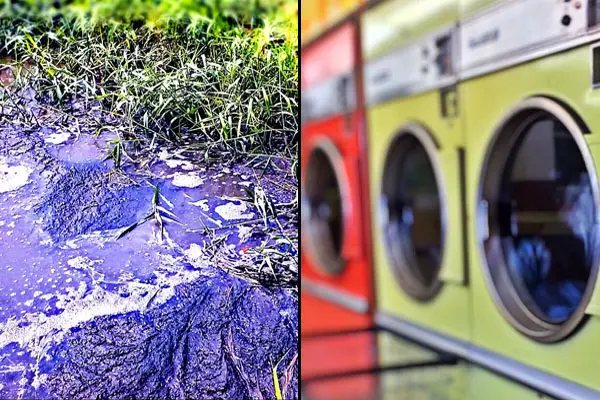Plastic pollution has had a devastating effect on the environment with its sources ranging from plastic containers to various products we used every day like toothbrushes and glasses. However, there is one source of plastic pollution that is not often discussed. Clothes, synthetic clothes that are made from toxic plastic particles that end up in the water while doing laundry.
“The clothing industry is the second largest polluter in the world, second only to oil,” “It’s a really nasty business. It’s a mess,” said high-end retailer Eileen Fisher.
Fast fashion is polluting the world, and we are contributing to the problem.
The History of Textile Pollution
In the 20th century, 81% of all fiber was natural, made of cotton, but after man-made fibers were created in the 1940s, the world started to turn away from natural materials. In 2014 U.S. imported more synthetic apparel than cotton ones, for the first time since 1991. Out of 19.43 billion square-meter-equivalents (sme) of clothing, 9.87 billion was made primarily of synthetic fibers.
A 2013 an Apparel Fiber Consumption survey by the International Cotton Advisory Committee (ICAC) shows that in 2010 synthetic fibers composed 60.1%, cotton 32,9%, cellulosic fibers 3.9%, wool 2.1%, and flax 1%.
Cotton is also becoming harder to grow enough of, as the world population is growing, but also because we live in a disposable culture, where people throw away perfectly good clothes all the time.
Meanwhile, synthetic fiber prices are going down, making it more likely for the manufacturers to use synthetic.
China is currently the top country that consumes the most synthetic fibers, followed by the United States, and then India.
Synthetic clothing is made from chemicals and includes materials such as nylon, acrylic, spandex, and polyester.

Source: International Cotton Advisory Committee
Tecnon Orbichem, a chemical industry analyst, predicts that soon more than 98% of fiber will be synthetic, with 95% of that made of polyester, which is the worst of all synthetics.
Polyester consumer clothing was first created by the chemical company DuPont in 1951. Its appeal was wrinkle-resistance and light weight. What people did not consider at the time, was its effect on our health and its impact on the environment.
Polyester is not biodegradable.
In China, petroleum-derived polyester textiles have already damaged a lot of the country’s waterways. The dyes and the chemicals in the fabrics contain toxins that end up in lakes and rivers and are causing hormone imbalances in the wildlife. Almost the third of China’s rivers are too polluted for human contact.
Homegrown Environmental Damage
How does clothing pollute environment? Besides its toxic production, synthetic clothing loses a lot of small plastic fibers each time you wash it.
About 1,900 microfibers are released from every piece of clothing every time it’s washed.
These tiny microplastics can be less than 1 millimeter across (0.04 of an inch) and are almost impossible to filter out. Most end up in the oceans and the marine life.
“A large proportion of microplastic fibers found in the marine environment may be derived from sewage as a consequence of washing of clothes,” according to ecologist Mark Browne.
Eventually, the microfibers make it inside humans through the food. It is predicted that one-third of all our food is contaminated by toxic microfibers.
They make it into the fishes’ stomach linings, and then we eat the fish.
“I don’t want to have eaten fish for 50 years and then say, ‘Oh, whoops’,” said Gregg Treinish, founder of Adventurers and Scientists for Conservation.
The majority of water plastic pollution (71%) in smaller bodies of water such as lakes is microfibers, which is why it is important to take steps to reduce textile pollution.
Toxic Fabrics to Avoid:
- Polyester: created from esters of dihydric alcohol and terephthalic acid (synthetic polymers)
- Acrylic: polycrylonitriles, which are carcinogenic
- Rayon: while made from wood, it is treated with ammonia, sulphuric acid, and other chemicals
- Nylon: made from petroleum, a carcinogen
- Water-resistant clothing: treated with perfluorinated chemicals (PFCs), such as Teflon, proven neurotoxins
Polyester can be made from recycled plastic bottles, but in the end, it still ends up in the same landfill. However, if you do buy polyester, choose recycled polyester.
Natural Fabrics to Buy:
- Cotton
- Silk (derived from Chinese silkworm)
- Hemp
- Wool
- Cashmere
- Linen (derived from flax)
Look specifically for organic cotton, as conventional cotton is often genetically-modified and requires a ton of chemicals to grow.
Cotton Issue That Need to Be Addressed
There is a strong need for a proper cotton disposal. While cotton is biodegradable, it requires to be chopped up into small pieces and provided water and oxygen for the process to begin. Unfortunately most cotton clothes also end up in landfills, which does not trigger decomposition.
What You Can Do to Reduce the Pollution
- Buy clothing made from natural materials
- Buy handmade instead of manufactured clothing
- Buy gently used clothing
- Reuse and repurpose clothing, swap still wearable clothes with your friends and neighbors
- Hand-dry your clothes. The dryer damages the fibers, making them looser, and escaping into the water with the next wash.
Related Reading: “My Plastic Free Life” Meet the Woman Who’s Given Up (Virtually) All Plastic Since 2007
Thanks for installing the Bottom of every post plugin by Corey Salzano. Contact me if you need custom WordPress plugins or website design.






